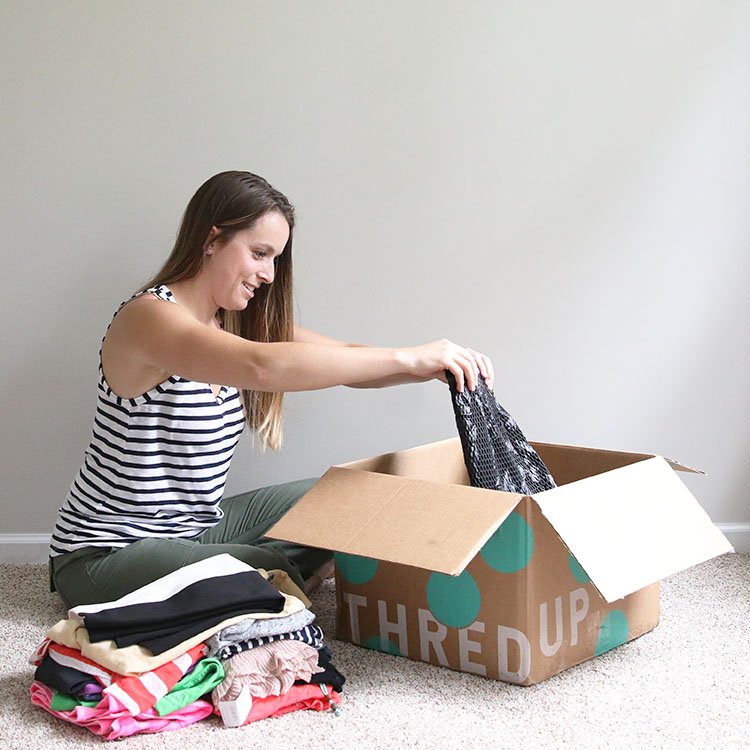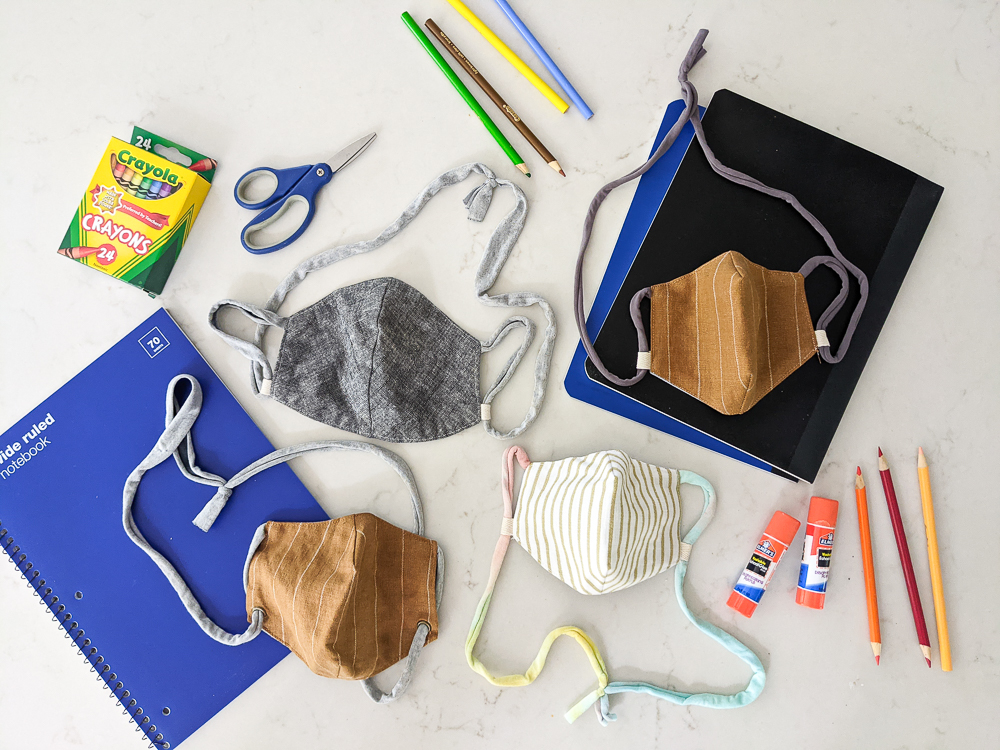Is Online or In-Store Shopping More Eco-Friendly?
Is online or in-store shopping better for the environment? As with most things, it depends, but here’s what the data tell us and how you can determine what makes the most sense for you.

I heard the doorbell ring and glanced out my window to see a delivery truck sitting in front of the house. As I headed downstairs to grab my package, I realized the delivery person I saw out the window wasn’t the one who had just rung my doorbell. I had two delivery trucks in front of the house at the same time. Even though no one else was home, I felt a little embarrassed.
I’m really not a shopaholic. I rarely buy something for the sake of getting something new. I almost always have a more intentional purpose for my purchases.
Recently, I’ve been receiving a lot of deliveries for a variety of reasons. We’re moving into a new house this week and have two guests rooms, a home office and a playroom that we’ve never had before. I’ve ordered sheets, mattresses, beds, a desk, a desk chair, and more online. While I recognize we may not “need” all these additional rooms, they certainly will be used regularly and aren’t being furnished to sit and collect dust.
With a recent move to a new climate, we needed more summer clothes, all of which I purchased from a few of my favorite sustainable brands (and all ordered online). The boys grow like weeds, so I buy their clothes secondhand from one of my favorite secondhand clothing site, thredup.
Check Out More Secondhand Shops I Like
I even order a lot of every day things online like diapers from Amazon, dinner from HelloFresh and craft supplies for specific projects. Needless-to-say, the delivery trucks are familiar with our address.
With two delivery trucks sitting in front of my house at the same time that day, I couldn’t help but wonder how my primarily-online shopping habits impacted the environment.
Was I feeding a carbon emissions problem by making nearly all my purchases online and leading delivery trucks to my house on a daily (sometimes twice daily) basis?
Spoiler Alert: For me, probably not. Generally though, the jury is still out.
Here’s what the research says.
How Much Marginal Driving Really Happens?
Whether shopping online or from brick-and-mortar stores, large tractor-trailers deliver the goods to our community from the manufacturer or distributor. Either the UPS and FedEx trucks drive packages to their distribution centers or Target delivers items to their local stores. These trips are likely fairly similar, so I suspect we don’t see a significant difference in the first leg of the journey.
After this checkpoint, a lot of variables enter into the equation. The remaining research isn’t conclusive, but we can get some directional support about our own habits with the conclusions derived from a host of studies.
Researching Purchases Online Helps
For those of us who research purchases and shop almost exclusively online, online shopping leaves a significantly smaller carbon footprint than traditional in-store shopping despite the delivery trucks and packaging. One paper from MIT in 2013 suggested a shopper who purchases exclusively online leaves half the carbon footprint of a traditional in-store shopper. Unlike traditional shoppers, online shoppers don’t drive from store to store to compare alternatives before deciding, and this generates most of the environmental benefit.
After deciding on a final purchase, traditional shoppers may link together a few errands to make one trip more efficient. Studies suggest, however, that we aren’t very good at this. Delivery companies like UPS and FedEx, on the other hand, put forth major investment of time and resources to determine the most efficient routes for delivery of goods (far more efficient and effective than a typical individual’s efforts to combine a few errands here and there). These combined considerations give another edge to online shoppers.
Where You Live Matters
Also worth noting, the shopper’s typical mode of transportation weighs heavily on the comparison. For those of us driving five or ten miles through suburban streets, the delivery truck probably transports goods to us more efficiently. Those of us living in urban areas, however, may be foregoing a walk, bike ride or public transit ride to a store in exchange for a delivery truck sitting in city traffic. As you can imagine, those variables dramatically change the trade-off of carbon emissions.
Planes, Trains, Automobiles … and Returns
Very few online shoppers purchase exclusively online. Online shoppers quickly lose their “competitive advantage” when we drive around town to find the perfect piece and then return to our computer to order it (or have it ordered in store for us) and have it delivered to our home. It’s basically the worst of both worlds, and we don’t have a lot of data on how often this happens.
Expedited shipping (like Amazon Prime, for example) often requires air travel, which has a significant marginal environmental cost over ground transport. Amazon offers an option to decline Prime shipping in exchange for certain store credits, which I often do when I won’t be needing something within the first two days.
Ordering something online for in-store pick up isn’t really advantageous, as you might imagine.
One of my biggest pet peeves of all, buying a boatload of things with the intention of returning a portion of the purchase, essentially negates any environmental benefits of shopping online. While I do return items, (and for full disclosure, I have purchased items at times about which I was uncertain when I knew I could return them), it drives me nuts to hear some shoppers brag about their habits of purchasing and returning large amounts of items just to try them on and return most everything on a regular basis. That’s so wasteful and feels like such impulsive and thoughtless spending. But that’s for another soapbox…
As you can see, so many variables come into play based on the circumstances of the shopper and choices they make throughout the purchase process that it’s hard to draw a specific conclusion about one being convincingly better than the other.
What Do We Do With Time Saved?
Thus far, I’ve alluded only to the specific components of a purchase transaction. But what about other indirect consequences of our decisions?
Another study considered the activities with which we refill the time we would have otherwise spent traveling from store to store. Are we really making an environmentally-beneficial decision if we purchase something online and then end up driving around town doing something else with that free time instead?
This study reviewed traffic over a period of time in a particular city and compared it to online sales in that same area. If online shopping offers a benefit of reduced driving and reduced carbon emissions, shouldn’t we see less traffic on the road? This particular study, for what it’s worth, found no drop in traffic despite an increase in online sales, suggesting we’re spending that time doing something else in our cars anyway.
If I’m being honest and if the study is correct that I’m replacing running errands with an outing with family, I’ll take it any day. Carbon emissions or not, more time with family and friends feels like an overall good trade-off to me.
And What About Packaging?
My research didn’t offer much in the way about conclusive studies on the packaging. However, it’s probably hard to argue that online shopping doesn’t lose to in-store purchasing in that respect.
The small plastic bags we get from so many retailers are horrendous for the environment, not only because of their sheer volume but also because they hamper the decaying process in landfills. Also, some stores receive items in lots of packaging that is removed before putting items on display, so we don’t see the volume of packaging. Yet, packages shipped in the mail come wrapped in so much packaging it’s sometimes silly.
Certain companies have made a concerted effort to go as green as possible in this respect, but most packages come covered in plastic and paper and tape and cardboard and even Styrofoam occasionally. I’m unscientifically concluding that in-store shopping wins the battle in this department for traditional retailers, especially when we can get motivated enough to bring our own reusable bags. If you’re purchasing online from an eco-friendly retailer that limits plastic and uses all recyclable or compostable materials, the online option is likely better.
So Should We Choose Online or In-Store Shopping?
We can’t decidedly hand an environmental victory to either shopping habit. But we do have pretty good directional evidence (that’s supported by common sense) to help us make decisions about how to shop if we want to score an environmental win as a bonus.
To the extent you can or need to, do research online. When you have a choice, try to buy from vendors who put some thought into their packaging material (some do a great job of keeping it simple and recyclable).
If you’re traveling a long distance to get to the store, let the delivery truck do the driving. If instead, you’re ordering from the local shop ten city blocks away from your loft, put on your walking shoes or grab your bike. It’s self-serving for your health anyway.
When you do make the trip yourself, bring your own bags. It’s so easy, and (in my opinion) those bags are much easier to fill and to carry than the flimsy plastic alternatives.
Lastly, don’t regularly buy things you think you’ll return. It’s wasteful. Even more, we often end up keeping more than we otherwise would have purchased, so it saves money not to ever let it enter our homes in the first place. Retailers know this, and it’s one of the main reasons they offer free returns. They know we will purchase more, thinking it can be returned, but we often won’t actually return what we think is just alright.
As you’re shopping, I encourage you to more thoughtfully consider what you buy and how you buy it. You may decide to stick with your original plan, but at least you made a conscious decision and briefly weighed your options. I’d be willing to bet a few intentional minutes spent considering viable alternatives might result in a lot of different choices about our collective shopping habits that could really make for greener consumption.










One note about in-store packaging I learned working for GAP/Old Navy for 5 years is that if you order online, it comes in a plastic bag individually wrapped and then a larger plastic bag around that bag as well. But when items come to the store, they still come individually wrapped in a cardboard box (better) but each item is usually in a bag group in another bag (all orange tank tops are in individual bags all within a larger bag that is in an even bigger bag of tank tops of all colors in a cardboard box) but everything that is on a hanger in the store comes prehung on a plastic hanger that does not get recycled or reused whereas online clothes don’t come with a hanger. When I look at it that way, avoiding the hanger which is far and away the most plastic is probably the best move . This type of packaging is pretty much industry standard for any store that uses plastic hangers.
Thanks for sharing! That’s really interesting to know and a great point to add to the conversation.
I really enjoyed this write-up, but want to comment on a couple things. It seems like with online shopping, there are far fewer major warehouses than there would be smaller retail outlets in traditional shopping. In addition, Target et al still have their major warehouses from which they supply the smaller retail outlets. I’m curious how completely removing the retail outlet from the equation impacts the environmental footprint. It seems to me the retail outlets are what would make the biggest impact on the comparison, for two reasons:
1) It would be far easier to plan for and prevent over-production/-import of goods using the large-warehouse-direct-to-consumer-household method, rather than having to stock dozens or hundreds of small retail outlets with sufficient goods, as not to sell out.
2) The costs involved in operating each retail outlet are massive. Heating/cool, lighting, maintaining, cleaning, design/appearance, and more. These all have an impact on the environment as well.
I really enjoyed your write-up, I just had this one thing to nitpick, and would love to hear your thoughts, or if you have discovered any new information since publishing this. Cheers 🙂
These are such great questions! I honestly hadn’t even thought about them, and they didn’t come up when I did my research (or maybe I didn’t dig deep enough on those areas specifically because I wasn’t thinking in that direction). Thanks for adding these points; definitely will be considering these for further questioning.
Further, on that point, many of the large box stores (and their massive parking lots) take up a lot of space. Imagine if those concrete spaces could be replaced with green spaces? That would be pretty great and certainly better for the environment. I am sure some of that space reduction would be offset by additional warehouses but certainly not all of it (probably not even close). Thanks again for adding this food for thought!
Now a days online shopping is very popular and eco-friendly also. I also get some ideas about online shipping by reading your post. Thanks for your kind post. Please keep sharing!